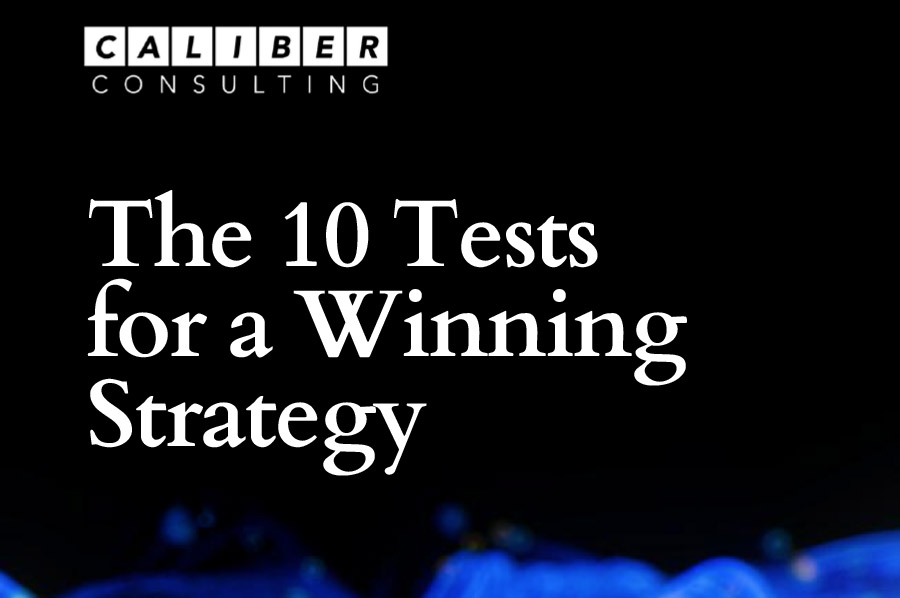10 tests to pass for formulating a winning strategy
A winning strategy is the centerpiece of any company’s success. Yet the reality is that most strategies underperform in one way or another, with research citing that even up to 90% of strategies fail to meet intended targets.
One major pitfall of new strategies is that they are not designed well enough, and as a result, the likelihood of realizing its underlying goals drops. So how can Chief Executive Officers and Chief Strategy Officers ensure that their strategy is setup for success?
After studying hundreds of organizations and the triggers for success, experts from Caliber Consulting crafted a 10-step test that helps leaders examine the rigor of their strategy.

Passing these 10 tests ensures that a robust and well formulated strategy is in place that has a greater chance of successfully navigating the pitfalls of execution.
1) The Specificity Test
A big issue with strategies today is that they remain ambiguous and lack clarity. They can often revert to poetic documents relaying how the organization wants to be customer centric, number 1, and put employees first. Winning strategies tackle the issues head on and have very specific and integrated choices, laid out.
2) The Linkage Test
Strategy often is developed and remains in the ivory tower of leadership. Great strategies cascade what is developed at the corporate level, so all business units are aligned with corporate strategies all the way down to the individual level. Vertical alignment will not only suffice, linkages should also be horizontal so that various business unit objectives and strategies are aligned with each other.
3) The Culture Test
We all know the famous saying that “Culture Eats Strategy for Breakfast.” But we often look at strategy as the driver of a culture change effort, and strategy as the force which shapes culture. However, on the flipside, some strategic options need to be filtered through a cultural lens to determine its likelihood of success. Is your culture ready to adopt that strategy?
If your strategy revolves around being first to market yet the behavioral realities are slow decision making, fear of failure, and silo working styles then you may have to rethink that strategy.
4) The It Was All A Dream Test
Strategies need to be bold of course, but often times they stretch the imagination and realms of reality too far. Make sure the strategy has realistic targets and ambitions, without that reality, the strategy is set for failure. This test gives your strategy a “reality check.”
5) The Operations Test
Strategy needs to be articulated into operational terms; it cannot be left at 25,000 feet at only a helicopter view. This means breaking down strategic choices into clear KPIs, targets, milestones, projects, roadmaps and building a clear link to budgets/resources and operational plans. Without operationalizing your strategy, it will be doomed for failure.
6) The Strategic Choice Test
Strategies can often be articulated by loose goals and objectives captured often in strategy maps. Even if these objectives are SMART they are not touching the essence of strategy. Strategy is about choice namely what is your organization’s playing field and within this playing field what is the winning formula for success. If those questions are not answered in depth, then you don’t have a strategy.
7) The Differentiation Test
Strategy is about being different and unique. Yet many organizations don’t carve out their unique value proposition deep enough in order to stand out of the crowd. Some markets and industries with monopolization or government entities may argue that they do not need a high degree of differentiation due to competition.
But this approach is rarely ever sustainable. Make sure you are not spreading your organization too thin by having too many priorities and not being differentiated enough. Remember “strategy is choosing what not to do.”
8) The Rigor Test
Some good strategies have been successful through just pure intuition and boundary stretching visions. However, for the most part, a winning strategy should be data driven and founded on rigorous analysis of both internal and external worlds the organization operates in. Strategy will always remain an art but needs to be balanced and revolve around science.
9) The Operating Model Test
Some great strategies have been torn apart by an internal operating model that wasn’t fit for purpose and aligned to the strategy. Some organizations have innovation central to their strategy yet deploy a hierarchical operating model with bureaucracy and slow decision making. This test, ensures structure, people, process, and technology are enabling the strategy rather than serving as obstacles to its execution and progress.
10) The Hearts and Mind Test
A strategy almost always brings about transformative change. Thus, the strategy needs to be looked at always through a change management lens. It must be communicated effectively ( we estimate that only 15-20% of employees really understand strategy) and even co-created at the development stage.

